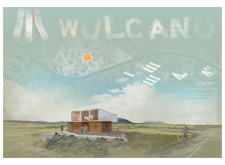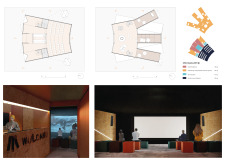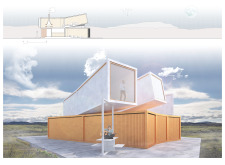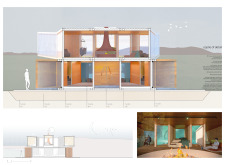5 key facts about this project
At its core, the Wulcano project represents the intersection of nature and community, designed to foster connectivity and adaptability. The building effectively serves multiple purposes, encompassing gathering spaces, flexible rooms for various activities, and a small movie theatre. These features highlight the project's intention to create a hub for community engagement, providing a backdrop for social interactions, cultural events, and recreational activities. The design aims to create a welcoming environment, where both residents and visitors can gather and share experiences, reinforcing community bonds.
The architecture of Wulcano is meticulously crafted, with important elements that enhance both its aesthetic appeal and functional efficiency. The use of large glass façades allows natural light to flood the interior, bridging the gap between the indoor and outdoor environments. This not only helps to create a warm and inviting atmosphere but also enhances the occupants' connection with the surrounding landscape. The careful orchestration of spaces promotes a flow that encourages movement and interaction, making the building more than just a physical structure; it becomes a living part of the community.
Materials play a crucial role in the overall design of the project. The selection of shipping containers as the primary building blocks reflects a sustainable approach to construction. These containers are both durable and versatile, allowing for creative spatial configurations. Interior finishes made from recycled wood panels complement the industrial exterior and contribute to thermal efficiency, adding a layer of warmth and comfort to the spaces. The integration of concrete foundations enhances structural stability, necessary for withstanding the unique challenges posed by the volcanic terrain.
Unique design approaches are evident throughout the project. By incorporating passive design principles, such as optimal building orientation and strategic window placement, Wulcano maximizes energy efficiency and minimizes environmental impact. The use of insulation materials further contributes to the building's performance, ensuring that it remains comfortable regardless of weather conditions. The thoughtful arrangement of spaces not only serves their intended functions but also encourages flexibility, allowing different community needs to be met over time.
The project emphasizes a contemporary architectural language while respecting the natural features of the landscape. The façade combines the rawness of industrial materials with natural textures, creating an appealing juxtaposition that resonates with its setting. This thoughtful design invites exploration and usage, making the architecture an integral part of its environment. The roofline, inspired by the undulating forms of volcanic hills, adds to the overall visual narrative, creating a dynamic silhouette against the skyline.
In examining the Wulcano project, one can appreciate the careful attention to detail in its architectural plans and sections. Each element has been considered with intention, contributing to both the aesthetic and functional outcomes. As you delve deeper into the architectural designs and ideas behind this project, you will gain insight into the meticulous processes that shaped its development. Exploring the various aspects of this architectural endeavor will enhance your understanding of how design can effectively respond to environmental challenges and community aspirations. This project stands as a testament to the possibilities within architecture, prompting further inquiry into innovative solutions and sustainable practices in contemporary design.


























